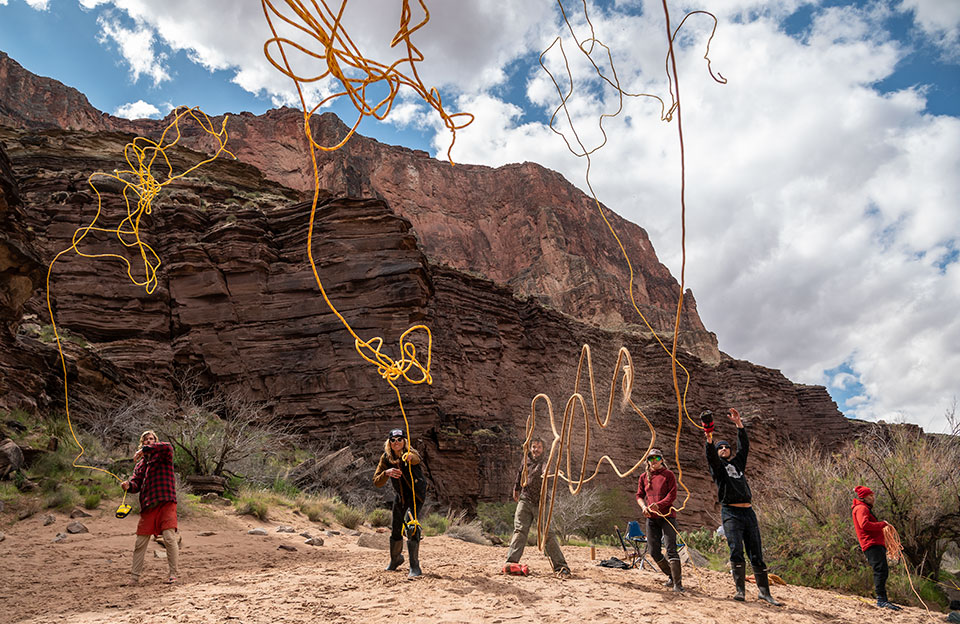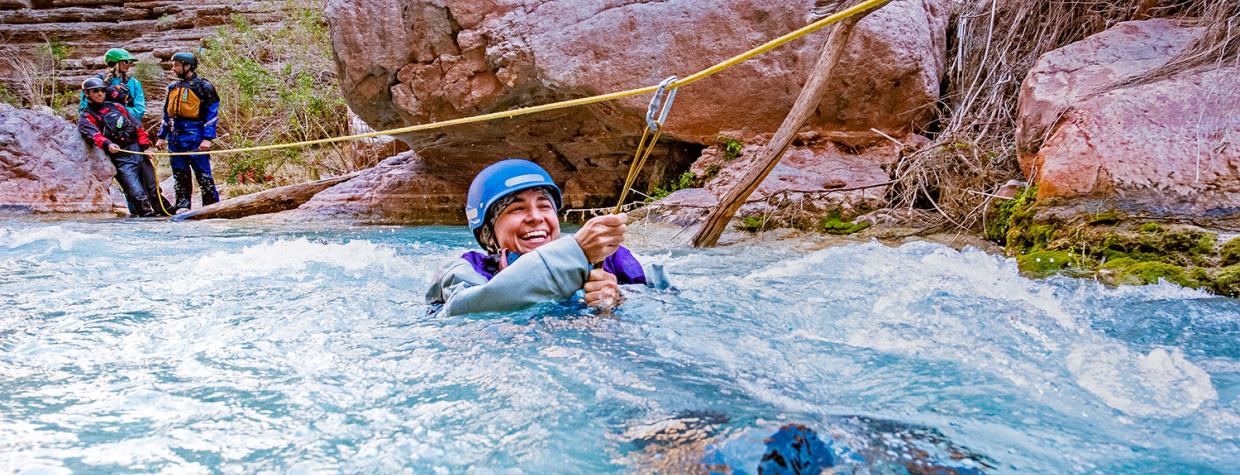“Live bait.”
That’s what today’s training is called. More properly, “tethered rescue” — an advanced swift-water technique for rescuing unresponsive victims from whitewater situations. The rescuer swims aggressively into fast-moving water in a specialized life jacket, tethered by a rope to a second rescuer on shore. The swimmer catches the victim and is swung back to shore by their partner. If anything goes haywire, the rescuer can pull a quick-release ripcord, be free of the tethering rope and move on to Plan B. It’s complicated, it’s tricky, and if you haven’t trained to do it, it’s dangerous. But it’s also incredibly effective, so we practice it. Over and over and over.
We’re on a guide-training trip with Canyon Explorations and Canyoneers, two of the dozen or so Grand Canyon river operators. Swift-water training is but one of many fields we’re covering: geology, biology and archaeology; rowing skills, knots and rope management; hiking routes and protocols. And other things you might not think of: modern sensitivity, educational theory, updates in medical care, interpretive skills, American Indian perspectives. Art history. Bees. Snakes. These are just part of what it takes to be a Grand Canyon river guide in 2021. You must maintain a wilderness first responder card, a CPR card and a backcountry food handler’s license, and you must pass your company’s drug-testing requirements. Only then are you ready to be last in a long line for a coveted job.
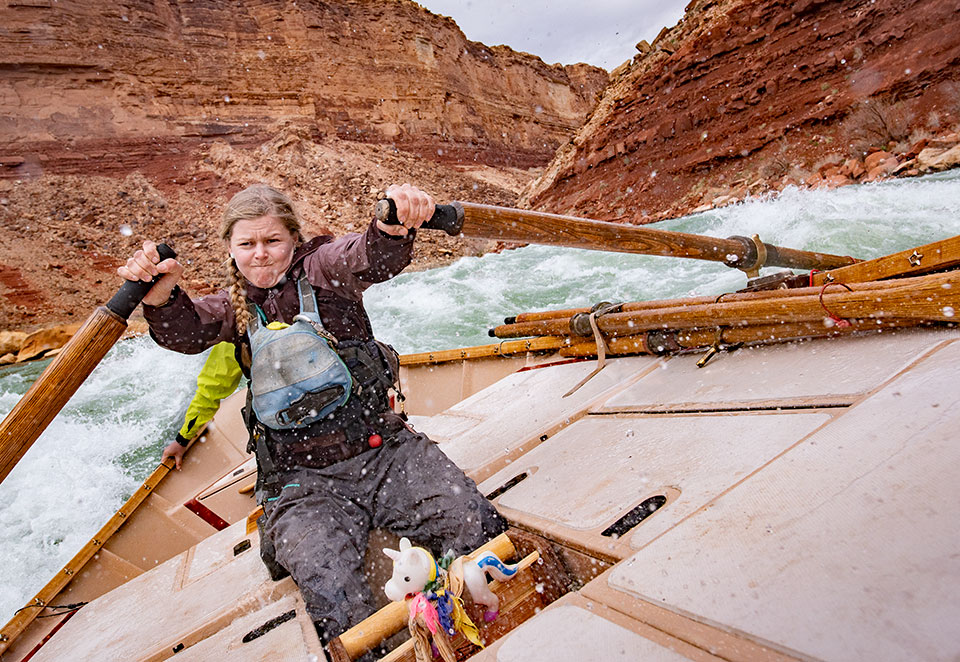
This fascinates me. My first Grand Canyon trip was 50 years ago. When I became a guide, there were few rules, scant resources and low expectations. To be a boatman (still the preferred unisex term), you had to be 18 years old, have three trips under your belt and be able to tell folks a bit about the place. To be the trip leader upped the qualifications: three additional trips, a Red Cross first-aid card, the ability to give a “suitable orientation talk” and be “a person whose character, personality and capabilities qualify him as a responsible leader.” Slim qualifications — and, to be honest, not every boatman met the requirements.
In the early 1970s, river guiding was an exploding opportunity, with the market expanding more rapidly than outfitters could train boatmen. There weren’t many seasoned guides, so there were few role models or mentors. A senior guide might have a dozen or two trips. It was a wonderful time to enter the business. We got to invent the systems, the camps, the hikes. If we got all of the boats and people to the end of the trip, we felt like we’d done a pretty good job. Things have changed.
Each evening, we land the boats and the crew transforms into a frenetic ant colony, scurrying from boats to beach with a table, another table, a third and fourth table, a stove, propane, pots and pans, water filters, toilet facilities, tents, duffel, chairs, and on and on. This is a training trip, so the entire group is in motion. One team will form the cook crew, preparing dinner and breakfast. We cook over a specialized gas stove and often show off by baking a cake in a Dutch oven. Each cook crew includes a senior guide to pass techniques and tricks on to newer guides. In recent years, we’ve been beset by snowballing numbers of dietary issues, allergies and preferences. On a recent trip, we prepared seven variant dinners.
Contrast that with 50 years ago: We would hit the beach, set up a table, throw down a fire pan made from a split 55-gallon drum, load it with firewood collected that day, torch it off and start cooking. Two meal options: Eat it, or go hungry.
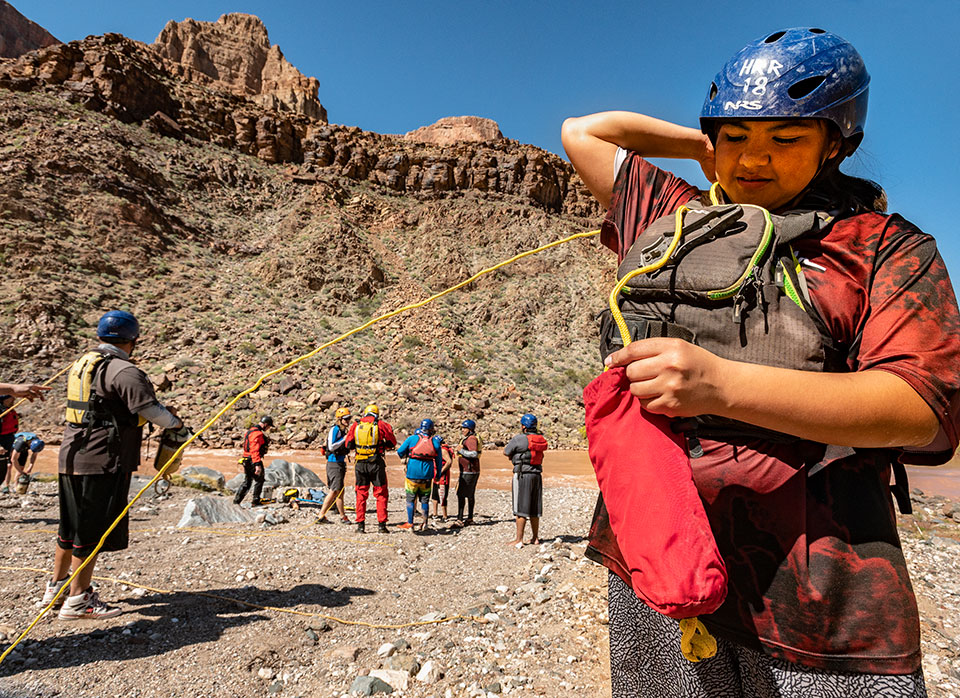
We have a wide array of boats this trip. Two dories, five rafts, three kayaks, a paddle raft, two mini-dories, a few other floating objects and Mandela van Eeden, who is swimming the entire river while clutching a foam river board. It might seem like we’re just goofing around, but rowing and paddling need coaching, too. Whitewater rowing is a relatively new science: begun in the 1860s, revolutionized 30 years later, re-revolutionized in the 1970s and ’80s. Many senior boatmen spent decades figuring out techniques, discarding old ones, understanding tricky runs and occasionally falling back on old habits. Now, we pass on what we’ve learned (minus the bad habits), sit back and watch new guides take things to a whole new level. It’s stunning to watch a first-year guide execute a run that took us decades of failed attempts to figure out. Stunning, and a little bit depressing.
At the site of the proposed Marble Canyon Dam, it’s my turn to speak. In my tenure on the river, I had the extreme good fortune to meet, work with and boat with three of the principals in the great dam fight of the 1960s: Martin Litton and David Brower — who, with the Sierra Club, mounted a nationwide campaign to save the Grand Canyon — and Stewart Udall, the pro-dam secretary of the interior who, in the face of overwhelming opposition, did a river trip and then an about-face. He pulled support for the dams and is known today as a great conservationist. The dams were never built. It’s an inspiring story of the little guy winning out over big business and politics. New guides learn this history and pass the inspiration on to thousands of river guests each year.
One of our talks is about the rules. The commercial operating requirements, like bureaucracy, inevitably change and grow. What’s new this year? How do we implement it? It used to be easier to follow the rules, because there were almost none — five and a half pages when I started, less than a page of which dealt with on-river operations. Now, we have 56 pages of detailed regulations and must know and abide by every one.
We practice using emergency communication systems. Satellite phones are now the standard, allowing us to talk with the National Park Service, managers and medical professionals to make informed decisions and expedite evacuations. The new topic this year is the Garmin inReach, a tiny texting gadget that pairs with a cellphone. It waits until a satellite is in range and — zap — sends the complete message out or a response back in. No more dropped calls or garbled meanings. Unfortunately, more and more guides and passengers have them, and we’re losing our obliviousness to the drama of the outside world. Every day, someone is telling someone else what’s happening “out there.” It’s heartbreaking to pop that blessed bubble we reveled in for so long.
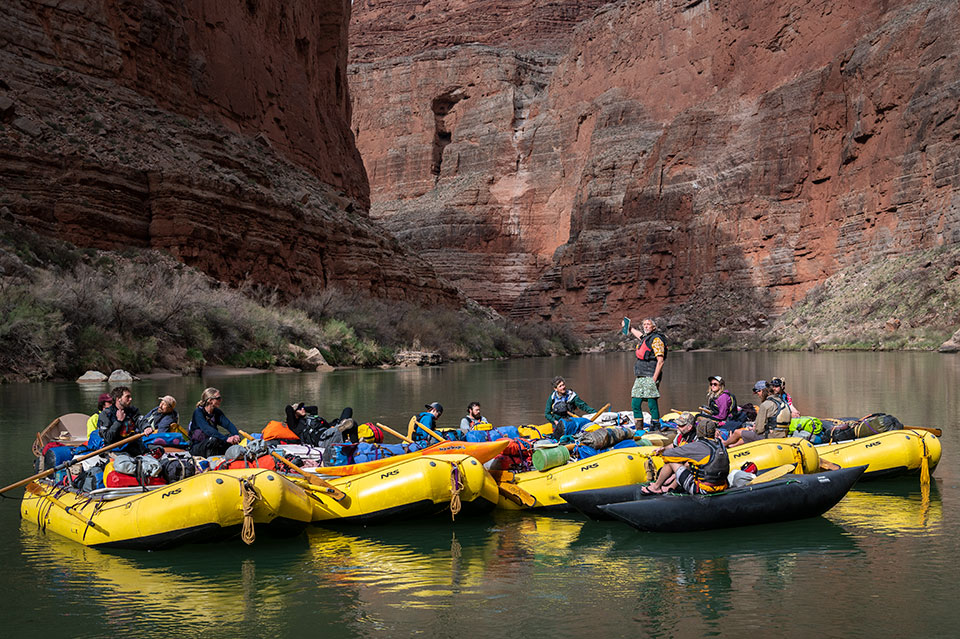
One morning, a small misfortune presents us with a remarkable learning opportunity. A young guide is rigging a raft when she suffers a seizure. The crew springs into action for real, stabilizing her, analyzing the situation and initiating her evacuation. Later, the Park Service helicopter arrives and lifts her to medical care. It turns out, fortunately, not to be a lasting medical problem, but the training it affords us is invaluable. Afterward, we go, step by step, through how decisions were made and how communication was handled, both with the outside world and among our own trip participants.
Much of a Grand Canyon river trip takes place on the shore. There are dozens of hikes that are normal parts of a trip, anywhere from a few minutes to several hours. On this trip, we choose lesser-known hikes to broaden the experience of both the newer guides and the veterans. At Mile 50, we climb the strenuous route to the Diving Board, a promontory several hundred feet directly above the boats. The pull of gravity is palpable. We scramble through the collapsed debris of Fishtail Canyon to see where an ancient landslide rerouted the creek bed. At two of the countless prehistoric sites, Helen Fairley, a longtime Grand Canyon archaeologist, details the many cultures that have inhabited the Canyon for the past few thousand years, blending that heritage into the modern tribes that now occupy the Canyon and its surroundings.
Our trip is but one of many training activities that go on each year; several outfitters run similar trips. Grand Canyon River Guides, a nonprofit, orchestrates a huge seminar each year near Marble Canyon — a two-day, land-based event with up to 500 guides in attendance, followed by a river trip with guides from nearly every company. Several organizations offer wilderness first-responder and swift-water training each spring. In the western Grand Canyon, the Hualapai Tribe runs one-day river trips and hosts its own medical and swift-water training.
For 15 days, we share and digest the stories of the Canyon. For as many nights, we savor the camaraderie of river life around the campfire, silence often being as important to our growth as more facts. Eventually, guitars come out, and music and laughter rise to the starry sky.
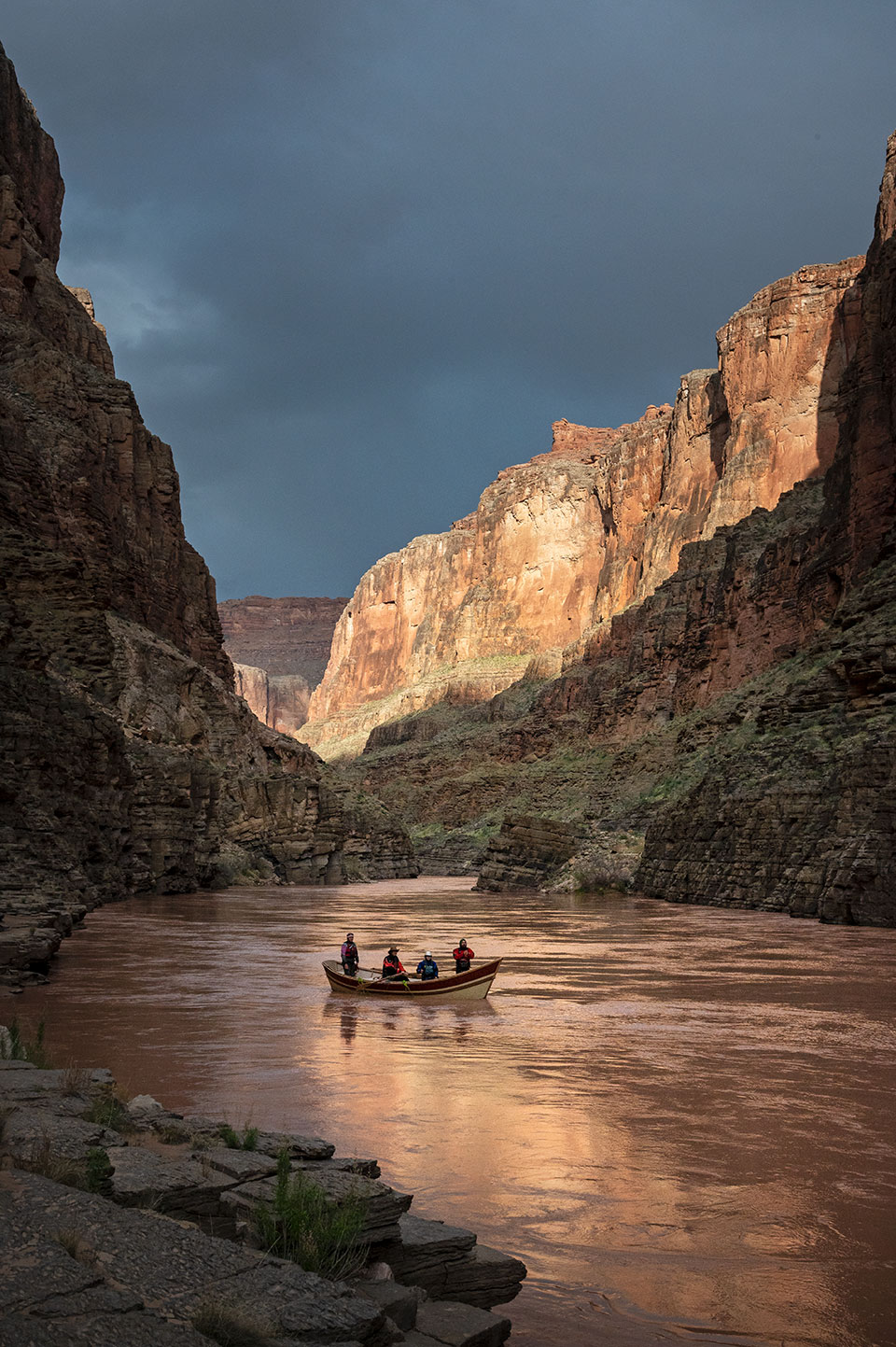
Being a guide has changed vastly over five decades. What once was a cadre of young, inexperienced white men now welcomes all genders, races and ages. To the old requirements of enthusiasm and fitness are added education and professionalism. We now are highly trained in ways we never dreamed of back then.
Is Grand Canyon boating so dangerous that these high levels of medical and swift-water training are dictated? No: Longtime Canyon clinic doctor Tom Myers found the statistical on-river risk when rafting the Colorado falls somewhere between those of archery and bowling. But life happens everywhere. Are the high levels of interpretive training necessary for guests to comprehend the Canyon? No, but they enhance and enrich natural and cultural awareness and help create advocacy for a precious and ever more threatened national treasure. But it’s more than that. Grand Canyon guides were never here for the paycheck. It’s always been passion that drew us on: to do it better, to honor the place and the profession. The spirit of the job, the community and the Canyon runs stronger than ever. It is unquenchable.
After 226 miles, we meet our vehicles at Diamond Creek and begin breaking down the gear and loading the truck. Here begins the disconnection from the real world and the re-entry to that crazy place above the rim. The transition can be jarring and disorienting, but this, too, is part of the life of a guide.
I smile when I see the truck driver — a tall, quiet, gray-haired gentleman named Cam. On my first trip as a boatman, Cam was the other guide, but not yet of legal age to lead. So I, being all of 21, led the trip. And here we are, five decades later. I’m still messing around in boats. Cam runs the company. His son Morgan is one of the trainees. The ripples spread, and the river flows on.
